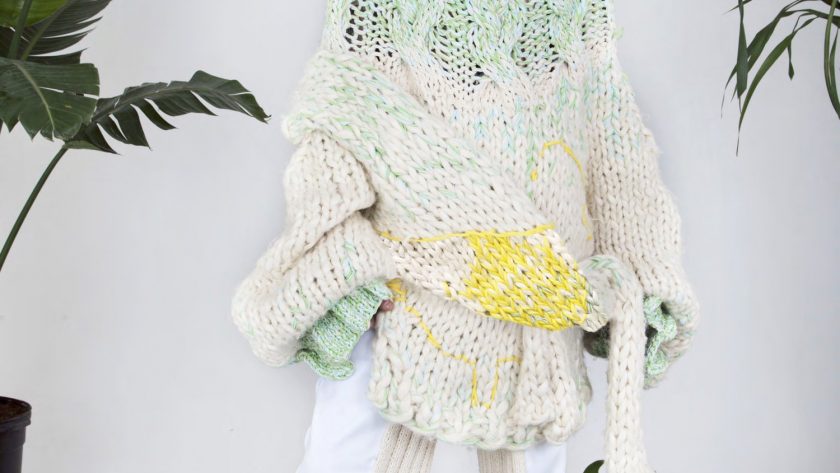Interview with NYC based designer Qiongxin Kou.

MM: As a designer in New York, the city that never sleeps, is there a strong feeling of being under pressure? Do you feel the push and pull?
Qiongxin: Yes, I do, but I feel a positive push to let myself grow faster and be more efficient to achieve my goals. I like being put under a bit of pressure when I need to be in a work mood.

MM: How are you influenced by your Chinese heritage? Can you explain the Chinese school of thought which you apply in your life?
Qiongxin: Mentally, Chinese culture and thoughts tend toward being gentle and being humble. There is one philosophy in China called ‘Overcoming hardness with softness’, which means you don’t have to use a hard attitude to conquer a hard thing; a soft method could work out with a better result. I love and believe in this philosophy so much, and growing under this gentle heritage I do everything with a peaceful and calm heart. I feel comfortable, powerful, and more efficient in achieving the best outcome by working in this way, especially in design. My design work is always in a fresh style, the colour palette is not aggressive but bright to give an eye-catching visual effect. The construction, cut, and materials of my design pieces are not angled and hard, but simple and soft, which give wearers a more comfortable and cozy experience, and this ‘cozy wearing experience’ means everything to me in producing designs.


MM: This philosophy is reflected in the soft knitted pieces of your work. Does your mood/feelings influence your design process?
Qiongxin: Yes, this is why I love haute couture techniques and try to incorporate hand-making skills in every collection. I love how delicate and original those hand stitches look on garments. Only a person who is in a peaceful and calm mood could bring that delicate beauty and quality look to life, it doesn’t matter with how simple or complicated the techniques. I love to deliver a very comfortable and wholesome wearing experience to my customers, so not only do I work in a soft mood but also choose soft fabrics and materials to complete my designs.

“I love and believe in this philosophy so much, and growing under this gentle heritage I do everything with a peaceful and calm heart…”
MM: Can you describe the ‘Bamboo Culture’ collection that we see here?
Qiongxin: Bamboo Culture is inspired by the physiques of bamboo which embody the values appreciated by the underlying philosophies of Chinese culture – Confucianism, Taoism, and Buddhism. Of the three, Confucianism teaches humanism, virtue, and self-behaviour; Taoism conveys harmony in nature and its ability to restore balance; Buddhism preaches karma and self-control. The three different schools share many common values, one of which is the fundamental belief of bamboo culture: self-actualisation through adequate reflection upon oneself and one’s relation to society and nature.
Inspired by Bamboo Culture, I want to create a slow design system that balances the industry and the environment around it. Beginning with using a zero-waste design process and sustainable materials, I increased the longevity of a garment while decreasing its eco-footprint. Every piece was finished by hand; I work closely with craftsmen to develop innovative methods of construction, fabrication, and treatment.


MM: As a creative practitioner, does being part of the slow fashion movement help you to be more mindful? How have you embraced sustainability into your design process?
Qiongxin: Yes, it helps, because if I choose to be part of slow fashion, I will be responsible not only for a more sustainable design process, but also in promoting cultural traditions that offer a social function. For example, in China, we have 56 ethnic groups, and in each group, they have their special traditional handcraft, such as natural dyeing, hand embroidery, weaving and so on. So, if I use one hand-making technique in my design, my work not only delivers the aesthetic but showcases my beautiful culture to the world.
Also through careful selection of methods in how I approach the production of my designs, I exclude many factors that have been harmful, superficial and wasteful, so the wearer can be free from these negativities, resulting in real responsible designs that will last.

MM: Is self-awareness important to you? To feel well- grounded and strong in both yourself and your role as creator? Does designing deepen your knowledge about yourself?
Qiongxin: Yes, of course. Self–awareness is very important to me. This lets me know who I really am; why I make every decision; how I communicate with myself and others ; and my living value in the world. Having clear self-awareness could help everyone see what is right, like if a person deeply knows themselves they would know how to act appropriately, and automatically care for the living environment, and would not need to be told by anyone else to protect the earth because it is a very good thing.
MM: What feeds your soul?
Qiongxin: My lovely growing environment and childhood built by my parents, this is the key reason to why I am ‘me’ right now, and why I think, talk, and communicate with the world this way. I feel so grateful for being their child, because my sincere, brave, and positive attitude along with my values were fostered from them.
Thank you Qiongxin for giving us an insight into your world and your softness philosophy. MM readers, what do you think? What feeds your soul?



